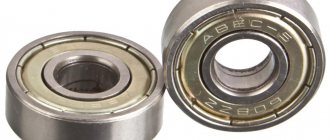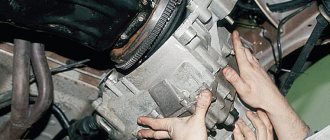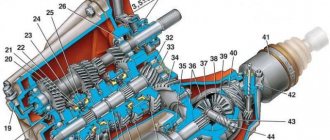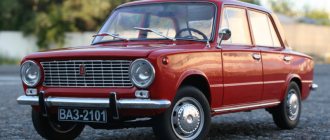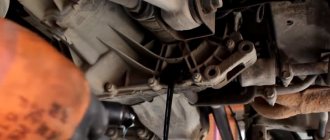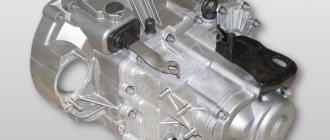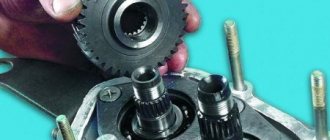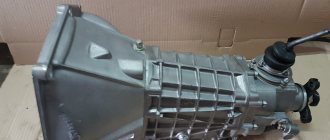Purpose of the sixth gear of the gearbox for a VAZ
There is an opinion that 6th gear is needed exclusively for moving on the highway, that is, we enjoy the absence of engine roar at high speeds.
Others see other advantages in this, such as faster, more dynamic and smooth acceleration, while maintaining maximum speed. And still others are trying to reduce gasoline consumption by installing a sixth gear in a VAZ. Despite a number of advantages of 6-speed over 5-speed, there are also opponents of such modification of the gearbox. They argue that there is no point in doing such tuning if there is a standard engine under the hood. In any case, whether to install 6th gear or not is up to you, but here is the approximate price tag:
Buy a 6th gear kit for VAZ 2108..2110
| Previously, cars were equipped with 4-speed gearboxes and at that time this was quite enough. Currently, the requirements have changed, and the speeds are completely different, which is why many modern foreign cars have a six-speed gearbox. Is it possible to install sixth gear on a VAZ of the tenth family and what will it change? |
| In online stores you can find many kits, including for the standard range of gearboxes. The approximate cost is 13 thousand rubles. |
Four-speed and five-speed manual transmissions
So, the so-called “four-step” was quickly replaced by a “five-step”.
Let us immediately note that the five-speed manual gearbox is not very different from the 4-speed gearbox in design (the shape of the rear cover and other elements are similar). The main distinguishing feature is the placement of the fifth stage (speed, gear), which is located at the end of the secondary shaft. The five-speed gearbox has the same ratios as the four-speed gearbox. Most of the parts are also the same, since the five-speed gearbox is based on the four-speed one. The 5MT gearbox has a primary, secondary and intermediate shaft. Structurally, the input shaft is the same as the four-speed gearbox, but the output shaft has a slightly different rear end where the fifth gear components are installed.
More precisely, at the rear end of the intermediate shaft there is a threaded hole into which a bolt is screwed in to secure the fifth gear gear block, as well as the reverse gear. The fifth gear itself and the reverse gear are located in the cavity of the rear cover; the hub of the fifth gear synchronizer clutch is installed together with the reverse driven gear on the secondary shaft. Next, behind the hub, a thrust washer and a bushing are installed where the fifth gear gear is located.
This additional fifth gear was used to allow the engine to operate at lower speeds when driving at high speeds. On the one hand, this solution increases the service life of the internal combustion engine and gearbox, and on the other hand, it saves fuel.
In simple words, owners of cars with a 4-speed manual transmission are very familiar with the situation when, when driving on the highway at a speed of 100-120 km/h and above in fourth gear, the engine speed is high, the engine and gearbox are very noisy under load, and fuel consumption is increased. To increase comfort, all that remains is to reduce the speed.
It was to solve this problem that the designers introduced 5th gear to reduce the load on the engine and gearbox, reduce noise and increase fuel efficiency.
As a rule, fifth gear is an overdrive (overdrive), it is recommended to engage it at a speed of 80-100 km/h on a flat road. At the same time, a further increase in the number of stages is possible and practiced (for example, MT6), but often most manual transmissions have 5 gears. The reason is the need for the driver to constantly change gears, which makes it difficult to control the vehicle.
Speaking of disadvantages, a 5-speed gearbox is more demanding on the oil level in the gearbox than a four-speed gearbox. If there is not enough oil in the box, it often happens that it is the 5th gear that fails first, and the gearbox begins to howl and make a lot of noise under load.
Gearbox 2110 2112
Gearbox 2110 2112 is of a mechanical type, having two shafts and five gears for forward movement and one in reverse. All forward gears at the gearbox have synchronizers. It has a joint design with a differential and main gear. The body is made of three parts. The material used is aluminum, which has such advantages as reduced weight, lack of corrosion and high strength.
Like any other gearbox 2110 2112 is designed for mechanical connection of the engine and wheels, which ensures the movement of the car. By changing gears, we move at one speed or another. First gear is used to start driving, and fifth gear for highway driving.
The VAZ 2110 2112 gearbox differs from the gearbox of eights and nines. This is a difference in the clutch housing and the design of the starter mounting. Gear ratios 1 – 3.636, 2 – 1.95, 3 – 1.357, 4 – 0.941, 5 – 0.784, reverse gear -3.53. The final drive has a ratio of 3.7 or 3.94.
The VAZ 2110 and VAZ 2112 gearbox is a reliable unit. Doesn't require very close attention. It is necessary to change the oil every 75,000 kilometers, which means this should be done infrequently. The replacement itself is quite simple. After driving a little, thereby warming up the oil, we unscrew the drain plug, having first placed the car over the pit or raised it on a lift. After the oil has drained, fill in new oil. Its level should be located between the two marks on the level indicator. That's all the wisdom.
Source
Advantages of the 4-speed option
Gearboxes
Many drivers praise the common four-speed gearboxes and do not trust the newfangled six-speed automatic transmission. They make the following arguments:
- Unreliability. Four stages are better because they have been invented a long time ago and are more reliable, and automatic transmissions with a large number of gears will break down more often.
- Money spendings. Firstly, the six-speed gearbox itself is more expensive than a four-speed gearbox. Secondly, its repair will require additional costs, since the automatic transmission mechanism there is more complicated, and in combination with the first point, the six-speed gearbox generally becomes a huge hole in the budget of the owner of a car with such a transmission.
- No differences. Also, supporters of the four-speed automatic transmission claim that there are no differences in driving sensations with different automatic transmissions, and they do not see the difference at all. Moreover, in their opinion, there are no differences in the technical part: fuel consumption, speed, smoothness of switching.
However, one should not draw hasty conclusions, since all these arguments are erroneous. A six-speed automatic transmission is far from a new item in the automotive industry, and all the errors (which may have occurred in the first generations of cars with such gearboxes) have long been corrected. The designs of these boxes are very similar, which means it is impossible to judge which automatic transmission is more reliable and practical - most likely, they are the same in this parameter.
When is replacement better than repair?
Repairing the gearbox eliminates the problem, but does not affect its cause, and also does not change the transmission parameters, with the exception of installing more powerful shafts and gears with a different gear ratio. However, it is impossible to repair the structural defects of the box if it does not meet the tasks set by the driver. In this case, the gearbox is changed to a more suitable one. For this reason, AvtoVAZ abandoned a number of rocker boxes. The potential for their modernization was exhausted, and without reworking the design, it was impossible to eliminate the cause of the claims made by drivers.
When the management of AvtoVAZ realized this, instead of rocker boxes they installed more advanced cable ones, which immediately eliminated the causes of two main complaints: difficult gear shifting in the cold and rattling of the gearshift lever even with a fully functional gear selection mechanism (GSM).
Classification by structure
Volkswagen Passat Das graue Auto Logbook Replacing the gear shift cable
According to the structure, car gearboxes are divided into the following types: two-shaft and three-shaft. Both have their own advantages and features.
Twin-shaft box: device and principle of operation
The drive shaft of such boxes guarantees connection with the clutch. The driven shaft has a parallel arrangement and contains a gear block. If necessary, the differential helps provide different angular speeds.
Mechanism
Communication can be provided through special cables and rods. The simplest option is cables. It is the most common and convenient for experienced drivers and beginners.
The operating mechanism of this device is similar to the principle of a three-shaft gearbox, the main difference lies in the gear shifting features. The division of the lever, when the gear is engaged, is carried out in the longitudinal and transverse directions. Gear selection occurs through the functioning of all elements and their interaction.
Three-shaft manual transmission
The structure contains a drive shaft and a driven shaft, both contain synchronizers with gears and a switching mechanism. The drive shaft provides connection between the mechanisms and the clutch system. Parallel to it there is an intermediate shaft, which includes gears in the block.
The mechanism responsible for switching is located on the body. Its design includes a control lever and sliders equipped with forks. To prevent both gears from operating simultaneously, remote control is provided.
Principle of operation
This type of gearbox does not involve transmitting torque to the front wheels. The consequence of movement of the control lever is movement of the clutch. As a result, thanks to the clutch, speed synchronization is ensured.
We install the gearbox back after tuning
When you install a gearbox that has a 6th speed on a VAZ 2109 back onto the car, it will touch the spar (see Replacing the front spar on a VAZ on your own), so the spar will have to be filed in place. To avoid this, you can try to find special engine mounts that will lower the engine and gearbox together, and thus, you won’t have to modify anything during installation. The process of tuning the box is not difficult, but there are many important and perhaps not entirely clear nuances, so I recommend watching the video on tuning the box.
Porsche's seven-speed manual transmission promises to disrupt the market.
Replacing the cuff of the secondary shaft of the VAZ-2107 gearbox
It will not be a big secret for anyone that all new car models are born taking the design of their predecessors as a basis. Auto company workers simply take the previous model, change some elements of the body and internal parts, add a couple of the latest technologies, and a new car model is released. Sometimes, such an approach gives a very good result and very successful vehicle models are born, with their own charisma and popularity among buyers.
Examples of the above are the Porsche 911, Boxster and Cayman. In these models, from generation to generation, something is taken from the previous model, slightly modified and released for sale. As a result of this approach, the world was presented with the first 7-speed manual transmission, which is nothing more than an offshoot of the 7-speed Porsche Doppel-kupplung (hereinafter PDK) automatic transmission with 2nd clutch, introduced 3 years ago. A seven-speed manual will be available at the end of 2013 in the Carrera S and 991 models.
When developing the new gearbox, Porsche designers worked closely with ZF. The goal of this cooperation was to produce car components that would meet the requirements of a sports car model.
So what is this extraordinary box? What does it consist of and how does it function? We will try to answer all these questions in this article, with the help of our reliable assistant - the Internet service for finding auto parts https://zap-online.ru, where you can always order and buy auto parts for any brand of car.
What does a seven-speed manual gearbox consist of?
The new transmission is essentially two parts or two gearboxes. Each box consists of 3 pieces smelted from aluminum, united into one whole - a back, a front and a removable lid. Although the specified parts are molded in different versions for different gearboxes in order to meet their special needs, approximately 1/3 of all the internals in both parts are identical to each other. Only the input shaft, main shaft, some of the gears and the differential are common. If we compare a manual and automatic transmission, the first one has two input shafts. The output shaft also has a generator drive flange, which transmits torque to the front axle in all-wheel drive models.
The manual transmission lubricates its parts and mechanisms with three and a half liters of hypoid gear oil. The automatic PDK needs 2 types of lubrication: in addition to three and a half liters of hypoid oil, the PDK needs 5.7 liters of hydraulic oil in order to keep the control circuit and clutch wet. The weight of the boxes also varies. If the weight of an automatic transmission is 120 kilograms, then the weight of a manual transmission is 90 kilograms.
The 911 reaches its maximum acceleration (290 – 310 kilometers per hour) in 6th gear, with seventh in reserve. 7th gear allows you to make the highway mileage stable, saving the car's fuel.
We bow our heads to the designers of Porsche for their invention of the seven-speed manual transmission. We hope to see this unit in other Porsche models soon.
Gearbox 2110 2112
Gearbox 2110 2112 is of a mechanical type, having two shafts and five gears for forward movement and one in reverse. All forward gears at the gearbox have synchronizers. It has a joint design with a differential and main gear. The body is made of three parts. The material used is aluminum, which has such advantages as reduced weight, lack of corrosion and high strength.
Like any other gearbox 2110 2112 is designed for mechanical connection of the engine and wheels, which ensures the movement of the car. By changing gears, we move at one speed or another. First gear is used to start driving, and fifth gear for highway driving.
The VAZ 2110 2112 gearbox differs from the gearbox of eights and nines. This is a difference in the clutch housing and the design of the starter mounting. Gear ratios 1 – 3.636, 2 – 1.95, 3 – 1.357, 4 – 0.941, 5 – 0.784, reverse gear -3.53. The final drive has a ratio of 3.7 or 3.94.
The VAZ 2110 and VAZ 2112 gearbox is a reliable unit. Doesn't require very close attention. It is necessary to change the oil every 75,000 kilometers, which means this should be done infrequently. The replacement itself is quite simple. After driving a little, thereby warming up the oil, we unscrew the drain plug, having first placed the car over the pit or raised it on a lift. After the oil has drained, fill in new oil. Its level should be located between the two marks on the level indicator. That's all the wisdom.
Arguments in favor of the 6-speed type
Now let's talk about the differences, and they really exist, and there are many of them. All these points can be considered advantages of a six-speed automatic transmission compared to a four-speed one.
- Comfort when driving a car. Thanks to the presence of more automatic transmission gears, they will shift more often and more smoothly, which means that during the trip there will be no sharp jolts with each gear change. In order to change gear correctly using a four-speed gearbox, you need to rev the throttle, since in this case there are not enough steps. With more steps, this problem does not arise, so it shifts more smoothly.
- Fuel consumption. A larger number of gears allows you to select the optimal gear for a given speed more accurately, so that the number of engine revolutions is minimal. This allows you to significantly save gas mileage in cars with a six-speed automatic transmission.
- Speed. The number of gears has little effect on the maximum speed of the car; other parameters are important here, such as engine power or exhaust system. However, a larger number of stages will ensure smooth acceleration, thereby reducing its duration. At higher speeds it is difficult to feel the difference. Let's just say that optimal transmission reduces engine speed, reduces not only fuel consumption, but also wear and tear on some vehicle systems.
Pros and cons of a short-throw rocker
The motorist should understand that replacing the VAZ 2114 backstage will bring not only positive aspects to his life, but also some difficulties, which is worth knowing in advance.
So, the clear advantages of such modernization include:
There is only one downside: reducing the force lever leads to an increase in the load on the synchronizers, which increases the rate of their depreciation by two or more times.
Gearbox type 0A4, manual transmission repair Volkswagen 0A4
Designations of type 0A4 gearboxes installed on VAG cars: FNE, FQZ, GQQ, GQR, GTB, GTU, HDR, HGN, HGP, HGQ, HGR, HGS, HJE, HJK, HNV, HQS, JCR, JCS, JCT, JCU , JCV, JCW, JCX, JCY, JQP, JVF, KBL, KBM, KBN, KBP, KCD, KJF, KPF, KQM, KRY, KWK, LEA, LEL, LFZ, LHP, LHW, LLL, LPU, LUB, LZY , MDM, MDZ, MHZ, MJN, MJT, MLS, MLT, MLU, MTG, MUB, MUC, MUD, MWW, MWX, NEN, NZA, NZB, PCH, PEW, PHB, PME, PNX, PNY, QFA, QGA , QGF, QGK, QPM, QPN, QQM, QQP, QSX, QSY, QTK, QVW, QWE, QWF, QXX, QXY, QXZ, QYA, QYB, QYC, QYD, QYE, QYF, QYG, QYH, QYJ, QYK , QYL, QYP, QYR, QZR, QZS, QZT, QZU, QZV, RAK, RAL, RAM, RAN, RGF, RGG, RNF, RNG, RNH, RNJ, RNK, RNL, RNM, RNN, RNP, RNQ, RNR , RPA, RSC, RSZ, RTA, RTB, RTC, RTD, RTE, RTF, RTG, RTH, RTJ, RTK, RTL, RTM, RTN, RTP, RTQ, RTR, RTS, RTT, RTU, RTV, RTW, RTX , RTY, RTZ, RWQ, RWR, RXH, RXM, RZU, SHY, SHZ, SLL.
5-speed gearbox 0A4 (rus.) Factory repair manual. Five-speed gearbox 0A4, with gearbox letters: GQQ installed on cars: Volkswagen Golf 5 / Volkswagen Golf 5 (1K1, 1K5) Volkswagen Jetta 5 / Volkswagen Jetta 5 (1K2) Volkswagen New Beetle (USA) / Volkswagen New Beetle (1C1 ) Skoda Octavia 2 A5 / Skoda Octavia 2 A5 (1Z3, 1Z5, 933) Audi A3 / Audi A3 (8P1, 8PA, 8P7) SEAT Altea / Seat Altea (5P1, 5P5, 5P8)
Volkswagen Passat B6 2005->: Manual gearbox and clutch (rus.) 5 – speed gearboxes 0AH, 0A4 and 6 – speed gearboxes 0AJ, 02S, 02Q.
Volkswagen Golf V 2004- / Volkswagen Jetta 2006-: Manual transmission (0AF, 0AG, 0A4) (rus.)
Volkswagen Caddy 2003->: Transmission 0AH and 0A4, clutch, drive shafts (rus.) 5-speed manual transmissions type 0AH (letter designations: FZU, HFN, FZT, GXZ, GUG, KBQ) and 5-speed manual gearboxes type 0A4 (letter designations: GQR, JCS, HQS, JCY, KBN, KBP).
Gearbox 0A4, Workshop Manual (eng.) Repair manual for manual transmission 0A4. Edition 07.2014 Five-speed gearbox 0A4 with gearbox letters: GQQ, JCR, LHW, KBL, KQM, KJF, LUB, LZY, MDZ, MWW, MWX, MTG, MDM installed on cars: Volkswagen Golf 7 / Volkswagen Golf 7 (5G1 , BA5) Volkswagen Golf Sportsvan / Volkswagen Golf Sportsvan (AM1) Volkswagen Golf 6 / Volkswagen Golf 6 (5K1, AJ5) Volkswagen Jetta 6 / Volkswagen Jetta 6 (162, 163) Volkswagen Golf Plus / Volkswagen Golf Plus (521) Volkswagen Golf 5 / Volkswagen Golf 5 (1K1, 1K5) Volkswagen Jetta 5 / Volkswagen Jetta 5 (1K2) Volkswagen Golf Plus / Volkswagen Golf Plus (5M1) Volkswagen Passat B6 / Volkswagen Passat B6 (3C2, 3C5) Volkswagen Caddy 4 / Volkswagen Caddy 4 (SAA , SAB, SAH, SAJ) Volkswagen Caddy 3 / Volkswagen Caddy 3 (2CA, 2CB, 2CH, 2CJ) Volkswagen Beetle / Volkswagen Beetle (5C1, 5C2, 5C7) Volkswagen New Beetle / Volkswagen New Beetle (1C1, 1Y7) Skoda Octavia A5 Mk2 / Skoda Octavia A5 (1Z3, 1Z5) Skoda Octavia 3 A7 / Skoda Octavia 3 A7 (5E3, 5E5) Skoda Yeti / Skoda Yeti (5L6, 5L7) Skoda Superb 2 / Skoda Superb 2 (3T4, 3T5) SEAT Leon Mk2 / Seat Leon 2 (1P1) 2006 – 2013 SEAT Altea / Seat Altea (5P1, 5P5, 5P8) SEAT Toledo / Seat Toledo (5P2) SEAT Ibiza Mk4 / Seat Ibiza 4 (6J5, 6J1) Audi A3 / Audi A3 (8P1, 8P7 , 8PA) Audi A3 / Audi A3 (8V1, 8VA, 8VS) Contents (repair groups): 00 – Technical data, 30 – Clutch, 34 – Controls, housing, 35 – Gears, shafts, 39 – Final drive – differential. Page 262. 7 Mb.
VW Golf 2015 ➤ Golf Variant 2015 ➤ Manual Transmission 0A4, Repair Manual (eng.) Repair manual for manual transmission 0A4. Edition 12.2014 Five-speed gearbox 0A4 with gearbox letters: NZA, QSY installed on cars: Volkswagen Golf 7 / Volkswagen Golf 7 (AU1, AU2, BX5, BX6) 2014 – Volkswagen Jetta 6 / Volkswagen Jetta 6 (162, 163) 2014 – Contents (repair groups): 00 – Technical data, 30 – Clutch, 34 – Controls, housing, 35 – Gears, shafts, 39 – Final drive – differential. 210 pages. 9 Mb.
How can I find the information I need here? Decoding the factory equipment of the car (English) Decoding the factory equipment of VAG in Russian! Diagnostics of Volkswagen, Audi, Skoda, Seat, error codes.
If you have not found information on your car, look at the cars built on the platform of your car. Most likely, the information on repair and maintenance will be suitable for your car.
6-speed gearbox
6-speed gearbox
The design of the 6-speed gearbox is fundamentally identical to the 5-speed gearbox. The crankcase cover is enlarged to accommodate the 6th gears and extended input and output shafts.
The 5th gear synchronizer hub is designed in such a way that it is possible to engage 6th gear using this synchronizer.
If you need to rent a bus, pay attention to the company www.amigodrive.ru, which has its own fleet, qualified drivers, and a flexible pricing policy. 6th gear parts are located in the gearbox housing cover
The gearbox housing cover also serves as a support for the gearbox shaft bearings
The 6th gear parts are located in the gearbox housing cover. The gearbox housing cover also serves as a support for the gearbox shaft bearings.
Unlike the 5-speed transmission housing cover, which is made of stamped steel, the 6-speed transmission housing cover is made of magnesium alloy.
The primary and secondary shafts are extended to accommodate the gear and 6th gear carriage gear. The 6th gear carriage rotates on a needle bearing mounted on the input shaft sleeve. This sleeve also serves as a support for the input shaft in the gearbox housing cover.
The 6th gear gear is mounted on the splines of the secondary shaft; The gear shoulder is inserted into a roller bearing located in the crankcase cover.
To avoid the transmission of vibrations and vibrations from the power unit, the gearbox control drive is made in the form of cable rods. To communicate between the gearshift lever - transmission control (in the cabin) and the gearbox, there are two cables.
Both cables transmit the select and shift strokes of the shift lever to the shift shaft. The mechanism (swing arm and shift lever) converts the movement of these two cables into axial and rotational movement of the shift shaft.
There is a square on the lid. With its help, during service work, you can fix the shift roller in a certain, predetermined position. This greatly simplifies the adjustment of the cable drive.
The engine torque is introduced into the gearbox via the input shaft. In accordance with the engaged gear, the torque is transmitted through the synchronizer hub for 5th/6th gears and the corresponding pair of gears to the secondary shaft and then to the driven gear of the main gear with the differential.
What is a short-stroke link?
The standard rocker on the VAZ 2114 is a very reliable device, and even in the event of any malfunctions, it is easily repaired, is unpretentious to donor parts and creates a general impression of an analogue of a Kalashnikov assault rifle from the world of automobile rockers.
But what is really not pleasing about it is the attitude of the designers towards the comfort of the car enthusiast; perhaps some of them think that clogging the gears with a sweeping click is stylish, but in reality it only distracts from the road. It was to resolve this situation that the short-stroke slide was created.
This engineering idea is not something innovative; this idea came to civil vehicles from the world of sports competitions, where fractions of seconds decide everything. Initially, to reduce switching time and increase its accuracy in sports, boxes with a lever mounted in the gearbox housing were used, but it transmitted vibrations and did not allow the creation of more convenient control methods.
Therefore, a mechanism called a rocker was developed, the task of which was to convey the motorist’s decision to shift the gear forks into the gearbox through racks located outside the gearbox housing. This gearbox control inherited the sweeping switching of the forks from its older brother - the “lever in the body”.
Therefore, this engineering solution was further improved, as a result of which a short-stroke rocker appeared on the VAZ 2114 and other cars.
Gearbox type 02S, manual transmission repair Volkswagen MQ250-6F
Designations of type 02S gearboxes installed on VAG cars: FNB, FNC, FND, FNG, FQF, FYG, GLB, GPS, GQL, GQM, GQN, GQP, GRM, GSR, GSU, GXV, HGG, HGH, HGJ, HGK , HGL, HGM, HHS, HHT, HJM, HJN, HXP, HYG, JAU, JCK, JCL, JCM, JCN, JCP, JCQ, JDX, JWN, JWP, JWX, JXP, JXQ, JXR, JYG, JYH, JYJ , JYK, JYL, JYQ, KKP, KRX, KVT, KVV, KVW, KVX, KVY, KVZ, KWA, KWB, KWC, KWD, LKA, MAW, MCB, MDP, MFR, MHQ, MUE, MUF, MUG, MUH , MUJ, MXQ, MYP, NBH, NBJ, NBS, NMY, NTG, PEQ, PHG, PPJ, PTU, PTW, PVN, QBN, QBP, QCN, QJX, QMV, QPS, QPT, QSZ, QVE, QVX, QWP , QWQ, QWR, QWS, QWT, QWU, QWV, QWW, QWX, QWY, QWZ, QXA, QXB, QXC, QXD, QXE, QXF, QXG, QXH, QYS, QYT, RMH, RNA, RSD, RSE, RSF , RSG, RSH, RSJ, RSK, RSL, RSM, RSN, RSP, RSQ, RSR, RSS, RST, RSU, RSV, RSW, RXL, RZF, SAP.
Six-speed gearbox 02S (rus.) Factory repair manual for gearbox 02S. Six-speed gearbox 02S, all-wheel drive, with gearbox letters: GQP, HJM installed on cars: Volkswagen Passat B6 / Volkswagen Passat B6 (3C2), Volkswagen Passat Variant B6 / Volkswagen Passat Variant B6 (3C5), Volkswagen Golf 5 / Volkswagen Golf 5 (1K1), Volkswagen Jetta 5 / Volkswagen Jetta 5 (1K2), Skoda Octavia A5 Mk2 / Skoda Octavia A5 (1Z3), Skoda Octavia Combi A5 Mk2 / Skoda Octavia Combi A5 (1Z5), Audi A3 / Audi A3 (8P1), Audi A3 5-Turer / Audi A3 5-door (8PA), SEAT Altea / Seat Altea (5P1). Type 02S gearboxes with different letter designations were installed on cars: Volkswagen Golf 6 / Volkswagen Golf 6 (5K1), Volkswagen Golf 6 Variant / Volkswagen Golf 6 Variant (AJ5), Volkswagen Jetta 6 / Volkswagen Jetta 6 (162), Volkswagen Golf Plus / Volkswagen Golf Plus (521), Volkswagen Touran / Volkswagen Touran (1T1, 1T2, 1T3), Volkswagen Golf Plus / Volkswagen Golf Plus (5M1), Volkswagen Eos / Volkswagen Eos (1F7, 1F8), Volkswagen Scirocco / Volkswagen Scirocco (137 ), Volkswagen Passat B7 / Volkswagen Passat B7 (362), Volkswagen Passat Variant B7 / Volkswagen Passat Variant B7 (365), Volkswagen Passat CC / Volkswagen Passat SS (358), Skoda Superb 2 / Skoda Superb 2 (3T4), Skoda Superb Combi 2 / Skoda Superb Combi 2 (3T5), Skoda Octavia 2 Russia / Skoda Octavia 2 Russia (933), etc. Contents (repair groups): 00 – Technical data, 30 – Clutch, 34 – Gear shift control, crankcase, 35 – Gears, shafts, 39 – Control of the gear shift mechanism. 195 pages. 35 Mb.
Volkswagen Passat B6 2005->: Manual gearbox and clutch (rus.) 5 – speed gearboxes 0AH, 0A4 and 6 – speed gearboxes 0AJ, 02S, 02Q.
How can I find the information I need here? Decoding the factory equipment of the car (English) Decoding the factory equipment of VAG in Russian! Diagnostics of Volkswagen, Audi, Skoda, Seat, error codes.
If you have not found information on your car, look at the cars built on the platform of your car. Most likely, the information on repair and maintenance will be suitable for your car.
Which gearbox is suitable for Priora?
If you need to replace a gearbox that cannot be repaired, it is best to install exactly the same one: then a minimum of alterations will be required.
Important: even the first generation manual transmissions (2170) were produced in two modifications, differing in the type of starter (on one it was secured with three bolts, on the other - with two).
If, in principle, you are not satisfied with the standard gearbox of the Lada Priora, install a French manual transmission, a Japanese hydraulic automatic transmission or a Russian-German robot from Kalina or Vesta. Such units will cost significantly more than the original ones, and will also require significant modifications to the car, but will provide a higher level of comfort.
For example, an automatic transmission from Granta will fit into a Priora without major modifications, but it is better to use a robot rather than a hydraulic automatic transmission: then you will be able to save a lot of money.
If this option doesn’t suit you, then it might be easier to change the car: a remodel can cost several hundred thousand rubles. And for 100-150 thousand you can get a good foreign car 15-20 years old, which will be much more reliable and comfortable than the Priora. Buying a contract unit or taking a transmission from a disassembly unit is a lottery in which not everyone is lucky. An inexpensive hydraulic automatic machine from a Japanese or German car will cost 30–50 thousand rubles, and no one knows how long it will work.
Which car is suitable for the gearbox on the Priora?
It will cost at least the same amount to install the unit and remodel the car, after which you will have to prove for a long time and painfully to the traffic police that no unacceptable changes were made to the design of the vehicle. And those that exist are within the permitted limits. The evidence will be an expert opinion, which is very difficult to get for free.
As a result, the total costs can easily exceed 200 thousand rubles, which is comparable to the cost of a fresh Priora or a ten-year-old well-maintained foreign car. Therefore, often, instead of asking which cars are suitable for the gearbox on the Priora, they switch to someone else: isn’t it cheaper to buy a foreign car?
Thus, the gearbox from any front-wheel drive VAZ is best suited for the Priora.
The device of a manual box with 3 shafts
The three-shaft gearbox consists of a main input shaft, as well as a secondary shaft, on which the main gears with synchronizers are located.
All these elements are located in the transmission housing and have high-friction plain bearings.
provides the transmission with initial movement from the engine. There are splined connections on the primary element on which it is installed. Behind the primary shaft there is an intermediate one, which is located parallel, in turn, gear blocks are rigidly fixed to the secondary shaft.
Synchronizers are fixed between the gears of the main drive; their main task is based on measuring the inclined transmission speeds of the main and secondary shaft, this is created using friction forces.
The synchronizer blocks have a rigid engagement with the main shaft and also have two components. The movement of the synchronizer blocks is carried out in the longitudinal direction thanks to splined guides. Old gearboxes do not have a full set of synchronizers; fortunately, modern transmissions are fully equipped with this set.
The transmission shift mechanism itself, which has three shafts, is located directly on the housing itself. From a design point of view, this device consists of a lever and special guides, which, using a fork, change speeds. Such a mechanism can be equipped with remote control. The gearbox housing is designed to accommodate various parts and other elements, as well as oil for lubricating rubbing parts.
When the lever is in neutral, all torque is not transmitted to the driven wheels. At the moment when the control lever moves, special guides move the synchronizer block, which in turn stops the input shaft and the gears can freely engage.
Technical characteristics of the VAZ 2112 gearbox
| Type | Mechanics |
| Number of gears | 5 |
| For drive | front |
| Engine capacity | up to 1.6 liters |
| Torque | up to 134 Nm |
| What kind of oil to pour | Lukoil TM-4 75W-90 GL-4 |
| Lubricant volume | 3.3 liters |
| Change of oil | once every 75,000 km |
| Replacing the filter | every 75,000 km |
| Approximate resource | 150,000 km |
Online manual for manual transmission VAZ 2112 is here
Electronically controlled continuously variable transmissions
As a result of the development of electronics, continuously variable transmissions with electronic control appeared, a representative of which is the Audi gearbox for the A6 2.8 model, equipped with a 193 hp engine. With. with a torque of 280 Nm.
The main elements of the A6 2.8 continuously variable transmission are:
- the activation mechanism for starting movement (clutches with discs in oil), driving and driven pulleys with axially moving discs and a steel belt designed to transmit power
- electronic-hydraulic transmission control system
- reversing unit
- final drive with differential
The variator consists of driving and driven conical pulleys with axially moving disks, and a special chain transmitting rotation. The driving drive receives rotation from the engine through an intermediate transmission mechanism, the driven drive transmits torque to the differential. When transmitting movement, the chain is always tensioned.
For smooth starting when engaging forward and reverse gears, a multi-plate clutch is used, activated using hydraulics. The direction of rotation is changed using the gears of the planetary mechanism.
To drive the driven pulley, a multi-row steel chain is used, and it is not the belt segments that contact the pulleys, as was the case in previous designs, but the beveled ends of the connecting axes of the links. To prevent slipping, the beveled ends are pressed by a complex follow-up hydraulic system, which creates at each moment the required pressure from 20 to 60 kgf/cm2. As a result, pin wear is only 0.2 mm over the entire service life.
The chain provides not only the transmission of a significant load, but also a change in the gear ratio in the range from 1:2.1 to 1:12.7. This made it possible to abandon the torque converter, and therefore additional power losses.
The gearbox is controlled using an electronic control unit. To make a certain decision, the control unit receives information from various sensors: engine speed, input gear speed, fuel pedal position, engine torque, gearbox oil temperature.
The electronic control unit is able to recognize by the nature of the movement of the fuel pedal which mode the driver prefers - economical or sport. In the latter case, already from a speed of 60 km/h, the variator switches on the “overdrive” mode, that is, it lowers the gear ratio. When you press the fuel pedal vigorously, the sport mode is activated. The control unit reacts by engaging a lower gear and in the presence of a trailer or a steep climb, and the need for engine braking. The control unit program allows the gearbox to operate in manual mode, when pre-programmed gear ratio values are retrieved from memory. In this case, the continuously variable transmission acts like a six-speed sequential shift gearbox.
An Audi with a continuously variable transmission consumes 0.9 l/100 km less fuel than a traditional automatic transmission and 0.2 l less than a five-speed manual transmission. At the same time, acceleration to 100 km/h takes 1.3 s and 0.1 s less time, respectively.
How to change gears on a Priora
page » How to change speeds on a Priora
In this article, I want to give a basic understanding of the essence of the gear shifting process, which will allow you to automatically select the right gear to drive each time in order to ensure the desired driving mode in a specific situation and get:
If we switch to second at this moment, the wheels will also move at a speed of 25 km/h, but the engine will spin at lower speeds, approximately 1800 rpm.
The engine will be under heavy load at this moment.
This is similar to a long and short lever - the long one is easier to move, but you need to cover a greater distance, while the short one will require more force, but you won't need to deflect it much.
Lada Priora Hatchback — WhiteAnomaLia — › Logbook › Shifting gears, how to and how not to)))
In non-professional circles, and often in professional ones, there are a lot of misconceptions about gear shifting. The purpose of this article is to tell you how to do it correctly.
We do not set ourselves the task of covering all aspects and talking about all the intricacies of gear shifting, for example, how and in what cases you can shift without using the clutch. We want to explain the correct basic technique.
This will answer almost all your questions and dispel any confusion, allowing you to confidently and correctly change gears both on the track and on the street.
First, we will explain what a gas booster is and why it is needed. Imagine that you are driving 60 km/h... Suddenly a fancy Sky with neon lighting “flies up” to you from the left and starts honking and accelerating. Of course, your action is to move on and I’m not in a hurry.
But suppose you decide to answer the “challenge”. You need to shift from 5th gear to 2nd. If you simply depress the clutch, engage 2nd gear and release the clutch, the car will jerk very strongly, and the clutch with the gearbox will have a hard time.
Why is this happening?
How to change gears correctly
Now let's discuss the details. Your car has started to move, first gear is engaged, the clutch pedal is fully released, and you are driving at low speed.
Smoothly pressing the gas pedal, accelerate the car to approximately 20 km/h, remove your foot from the gas pedal and quickly, but not sharply, press the clutch pedal all the way.
Immediately move the gear shift lever to the neutral position for one or two seconds (at this time the gears in the gearbox equalize the rotation speed), and switch to second gear.
After changing gear, you need to quickly, smoothly release the clutch pedal and increase pressure on the gas pedal. Thus, you increase the fuel supply and accelerate the car in second gear, the speed becomes about 30-40 km/h.
The procedure for switching to third gear is the same as when switching from first to second, the only difference is that when accelerating you should reach a speed of about 35-40 km/h. Have you mastered driving in third gear? It's time to move on to the fourth, and then to the fifth.
How to learn to shift gears correctly
Of course, one of the best options for mastering gear shifting is to turn to experienced and responsive instructors. In addition, the driving school has a high level of classroom equipment, the availability of specialized simulators and all the necessary literature, and the attractiveness of the cost of training simply cannot leave anyone indifferent.
In the technical aspect of driving a car, the ability to correctly shift gears of a manual transmission is the most difficult and most significant moment.
Although it is the “mechanics” that allows you to get real pleasure from driving and from deciding exactly how to get started and how intensely to accelerate, and the level of extreme driving requires the ability to
change speeds correctly.
A few tips for learning how to change gears correctly on a manual transmission while driving.
In order to change gears on time and make the vehicle move more dynamically and economically, a scale of the so-called speed range was developed. So there is the following gradation, which tells us when and at what speed we move the gearshift lever to the next position.
Greetings to my blog readers! Do you remember your first trips behind the wheel of a car? Maybe my father was sitting next to me, or maybe it was a driving school instructor. One of the biggest challenges a new driver has to face is shifting gears.
After all, at this time you still need to not lose contact with the road and the environment. Getting the car moving becomes a difficult task for many.
How to correctly change gears on a manual transmission while driving is what I want to talk to you about on the pages of today’s review.
How to change gears
The figures given in the table are different for different machines. For example, for VAZ 10 family cars you need to add 10 km to each speed (in 2nd gear you can accelerate to 90 km/h). You can determine the upper limits for your vehicle using a tachometer. As a rule, the upper limit is 5.5 thousand revolutions (for normal driving it is better to switch to 3 thousand).
4. At the crossroads. For example, the light is green ahead and there are no cars, fourth gear is engaged and the speed is 60 km. When there are 70 meters left to the intersection, you can shift into third gear and complete the maneuver with the permission signal, even if at that moment the traffic light starts flashing.
The main advantages of six-speed gearboxes
The technical superiority of the 6-speed gearbox over previous models is as follows:
- By reducing the gap between gears, gear changes are carried out much faster (a new term “short-throw gears” has appeared).
- The 6-speed automatic transmission dcps has an increased service life.
- A decrease in the number of revolutions of the output shaft leads to a decrease in fuel consumption (especially good savings on gasoline or diesel fuel are observed when operating a car on country roads).
- Dynamic characteristics have been improved (car acceleration to 100 km/h).
- With the help of an electronic unit, the best conditions are created for switching to another mode.
- Improved driving comfort.
The 6-speed manual transmission does not differ in maintenance requirements from the five-speed design. Components and consumables have similar prices. The degree of complexity and price of repair work are also comparable to the previous version.
Disadvantages, breakdowns and problems of the Lada 2112 box
Owners consider the gearbox to be unreliable and criticize it for unclear switching and a strong whine.
People often complain about crackling and noise during shifts due to synchronizer wear.
Also, oil leaks from oil seals, pan gaskets and even breather often occur.
Wear of plastic bushings leads to failure of engagement or knockout of the gear
After 100 thousand km, some gears and bearings may exhaust their service life
Video about repairing a 5-speed manual transmission from a VAZ 2112
All texts were written by me, are authored by Google, included in the original Yandex texts and notarized. For any borrowing, we immediately write an official letter on company letterhead in support of search networks, your hosting and domain registrar.
Next we go to court. Don’t try your luck, we have more than thirty successful Internet projects and have already won a dozen lawsuits.
Source
Toroidal variator
Continuously variable transmissions also include a toroidal variator, used in Japanese-made cars “Gloria” and “Skyline”.
The variator consists of coaxial drives 1, driven 2 and intermediate rollers that transmit torque from one drive to another. One disk is the master and the other is the slave. Torque transmission is ensured by friction forces between the working surfaces of the disks and rollers. To change the gear ratio, the position of the rollers and their radii along which the rollers roll the disks change.
Depending on the angle of rotation of the roller, the driven disk can rotate at the same speed as the driving one (if the roller is horizontal), with more or less (if the roller rotates).
Since all the force is concentrated in the contact patch, special devices must be used to rotate the rollers that can overcome the force of pressing the roller against the disk (up to 3000 Nm). The ability to transmit such forces is ensured by the use of high-quality steels, special oils and a special system in which a precision hydraulic mechanism controlled by an electronic control unit moves the cages with rollers up or down by a microscopic amount, and then, due to the resulting shift relative to the axis of the disks, the roller rotates itself . In addition, in order to unload parts and reduce the size of the toroidal gearbox, it uses two variators. When using a toroidal variator in a car transmission, just as in the case of a V-belt, it is necessary to ensure the possibility of obtaining reverse gear and disconnecting the variator from the engine using the clutch. Reverse gear is provided by a planetary gear, and a torque converter is used for neutral gear.
For lubrication of continuously variable transmissions there is a special oil marked CVT, which is not compatible with ATF oil used for traditional automatic transmissions.
Continuously variable transmissions have not yet found widespread use due to some significant disadvantages they have compared to manual manual transmissions (size, weight, conversion range, manufacturing costs, gearbox efficiency, layout limitations).
Transmission tuning. How to choose gear ratios for a gearbox?
Most of the technologies used in transmission tuning are proven in motorsports.
The transmission of any, especially a sports car, is the most important mechanism for realizing the dynamic characteristics of the engine. Even with a relatively weak engine, the car can be fast due to correctly selected gear ratios. In motorsport, synchronized (as on 'road' cars) and non-synchronized (cam) gearboxes are used. Based on the shifting principle, they are divided into conventional (H-pattern) and sequential (with sequential gear selection, like on motorcycles).
In cars of a fairly serious level of preparation, cam gearboxes are used. They have a number of advantages - they can withstand higher loads (due to the shape of the tooth and the gear-cam clutch engagement), allow experienced pilots to spend less time changing gears due to incomplete squeezing of the clutch or without squeezing the clutch at all, they do not destroy synchronizers (which are simply No).
For normal road traffic, cam gearboxes are practically unsuitable, since they are quite noisy (due to the operation of spur gear pairs), “hard” when engaging a gear, and have a relatively short resource. In addition, they are disproportionately more expensive than synchronized ones and require regular qualified maintenance.
Synchronized gearboxes differ from standard ones only in gear ratios. In some cases (VAZ-2108 and -2110) it is possible to add a 6th gear. The correct selection of gear ratios of the main gearbox pair, the input shaft and the driven gears of the secondary shaft is the key to coordinated operation of the transmission. Gear ratios are selected depending on the power and torque characteristics of the engine, wheel size and, most importantly, on the wishes of the car owner.
6-speed gearbox for VAZ 2110 purpose and installation
| Previously, cars were equipped with 4-speed gearboxes and at that time this was quite enough. Currently, the requirements have changed, and the speeds are completely different, which is why many modern foreign cars have a six-speed gearbox. Is it possible to install sixth gear on a VAZ of the tenth family and what will it change? |
Purpose of the sixth gear of the gearbox for a VAZ
Despite a number of advantages of 6-speed over 5-speed, there are also opponents of such modification of the gearbox. They argue that there is no point in doing such tuning if there is a standard engine under the hood. In any case, whether to install 6th gear or not is up to you, but here is the approximate price tag:
6th gear kit for VAZ and the necessary tools
Need to purchase:
- Roller bearings. They are pressed into the lid. In my case, the standard bearings of the primary and secondary shafts (small and large) were suitable.
- 6th gear gear of the secondary shaft. In our case (7th row) it was the stock 4th gear.
- Needle bearing.
- 1st-2nd gear synchronizer hub.
- Block. synchronizer ring.
- Retaining rings (standard from 1-2 gears) – 2 pcs.
- Bolt from RTD (M6, hex head).
- M8 studs about 70 mm long – 2 pcs.
If the gearbox row is not 7 (i.e. if the 5th gear needle bearing is installed without a spacer), then a spacer is needed. There is no need to buy shaft nuts, they are not needed.
- Hexagon 12. Good, able to withstand tightening with a pipe.
- Thread locker.
- Bulgarian.
- Drill with a cutter (possibly).
Inspection and repair
After dismantling, parts and assemblies are cleaned and their condition is checked. The crankcase and clutch should be free of chips and cracks. The sliding surfaces are inspected for signs of wear or damage. The bearing clearance should not be more than 0.05 mm. The wear of the seals should not exceed 1 mm. The teeth and landing shafts must be free of chips, cracks and nicks. The shafts must not have any dents. If defects are found, the parts should be replaced with new ones.
If you replace or repair the gearbox yourself, the warranty on the unit will be lost. It is retained only when serviced at certified service stations.
If you need to replace the VAZ 2114 gearbox, you can save money and install a rebuilt unit. It will cost 30-70% less than new. If you decide to make such a purchase, choose only proven companies that have been operating on the market for more than one year.
